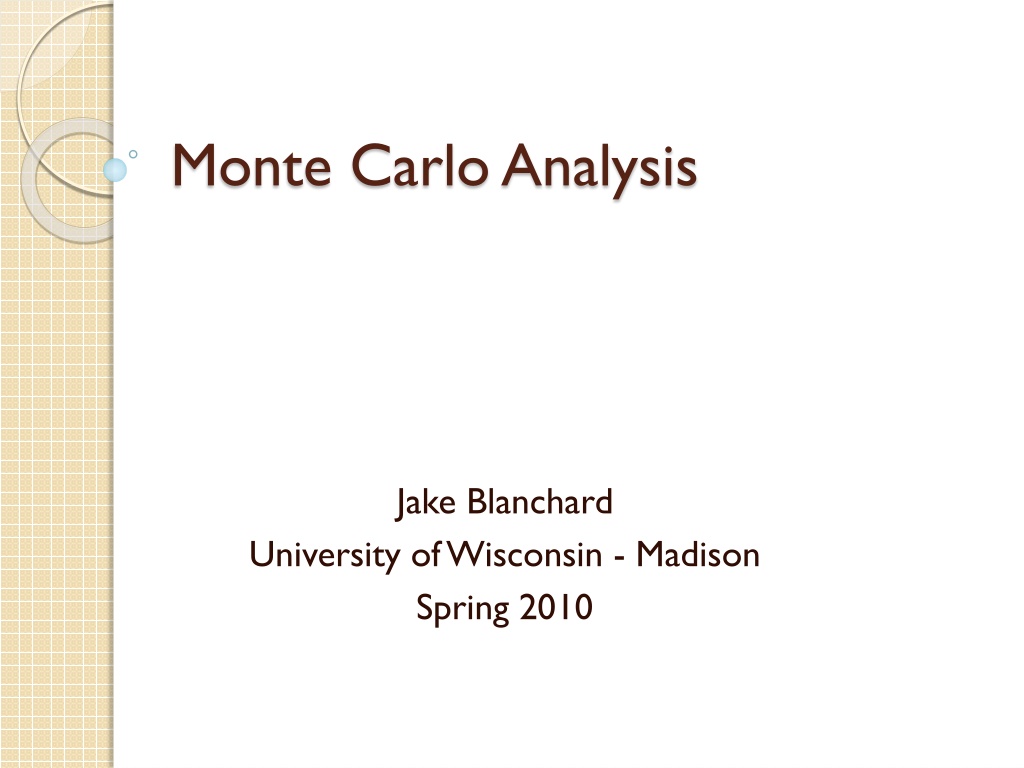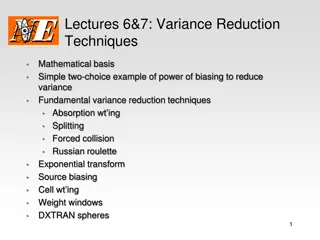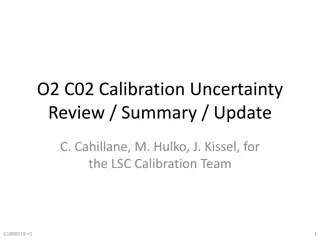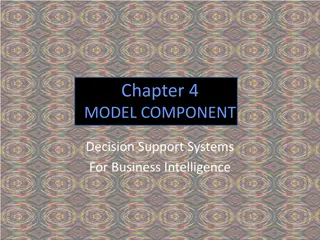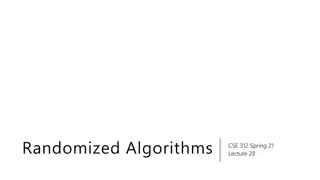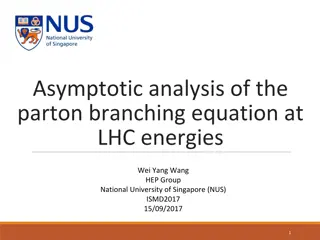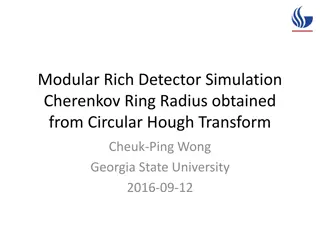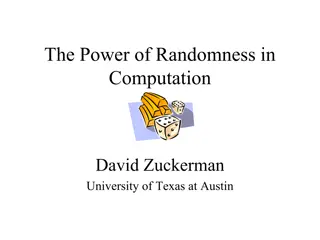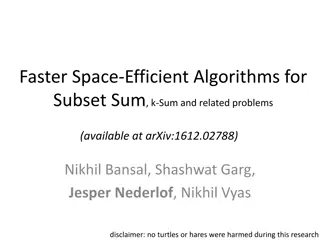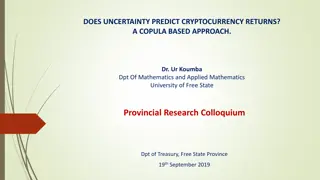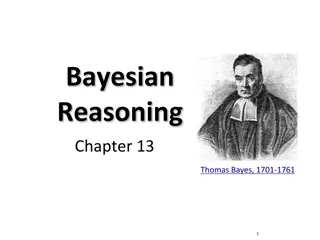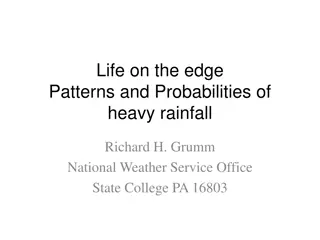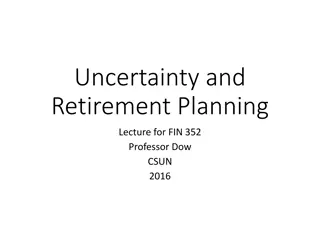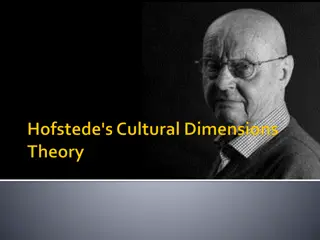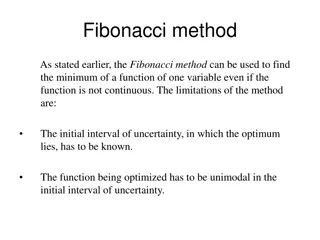Understanding Monte Carlo Analysis for Uncertainty Assessment
Exploring the concept of Monte Carlo analysis as a method of uncertainty assessment through sampling inputs, running models, and analyzing outputs. Learn how to simulate dice rolls, evaluate probabilities, and assess accuracy with sample size. Monte Carlo approaches are versatile and applicable to various problems beyond simple simulations.
Download Presentation

Please find below an Image/Link to download the presentation.
The content on the website is provided AS IS for your information and personal use only. It may not be sold, licensed, or shared on other websites without obtaining consent from the author. Download presentation by click this link. If you encounter any issues during the download, it is possible that the publisher has removed the file from their server.
E N D
Presentation Transcript
Monte Carlo Analysis Jake Blanchard University of Wisconsin - Madison Spring 2010
Introduction Monte Carlo analysis is a common way to carry out uncertainty analysis There are tools you can add in to Excel, but we will start by doing some of this on our own. I will use Matlab, but other tools work as well.
Monte Carlo Analysis The general idea is to sample the inputs, run a model, and thus get sampled output We can then look at averages, variances, probability distributions, etc., for the output Decisions can then be made from these results
An example: dice How can we simulate the rolling of a dice? If we could simulate such a thing, what questions could we answer? What is probability of rolling a 6? What is the probability of rolling snake eyes? What is the probability of two dice summing to 7?
Simple Code for Dice d=randperm(6) or n=1000000; roll1=ceil(6*rand(n,1)); roll2=ceil(6*rand(n,1)); tot=roll1+roll2; six=numel(find(roll1==6)); prob=six/n snakeeyes=numel(find(tot==2)); prob=snakeeyes/n sevens=numel(find(tot==7)); prob=sevens/n
Other questions What is accuracy as function of number of samples?
Plot -1 10 -2 10 std -3 10 -4 10 3 4 5 6 10 10 10 10 N
Code for Error Plot clear all n=1000; ntries=100; roll1=ceil(6*rand(n,ntries)); roll2=ceil(6*rand(n,ntries)); tot=roll1+roll2; for i=1:ntries sevens=numel(find(tot(:,i)==7)); prob(i)=sevens/n; end mean(prob) std(prob)
More Monte Carlo Monte Carlo approaches are also applicable to other types of problems: Particle transport Random walk Numerical integration (especially many- dimensional)
An Example Random walk Assume path length per step is fixed Randomly sample angle at which step is taken Repeat many times and study resulting path This is not the only algorithm for random walk. Many limit to finite number of directions and vary length from jump to jump
clear all steplen=1; startx=0; starty=0; nsteps=100; angle=2*pi*rand(nsteps,1); dx=steplen*cos(angle); dy=steplen*sin(angle); x(1)=startx; y(1)=starty; for i=2:nsteps x(i)=x(i-1)+dx(i-1); y(i)=y(i-1)+dy(i-1); end plot(x,y,0,0,'ro','LineWidth',2) Sample
4 Runs for 5 Steps Each 3 3 2 2 1 1 0 0 -1 -1 -2 -2 -3 -3 -2 0 2 -2 0 2 3 3 2 2 1 1 0 0 -1 -1 -2 -2 -3 -3 -2 0 2 -2 0 2
4 Runs for 50 Steps Each 5 5 0 0 -5 -5 -5 0 5 -5 0 5 5 5 0 0 -5 -5 -5 0 5 -5 0 5
Another Example Numerical integration (2-D, in this case) Draw area within a square Randomly locate points within the square Count up the number of points (N) within the area Area=area of square*number points inside area/N
Example clear all squaresidelength=2; area=squaresidelength.^2; samples=100000; x=squaresidelength*(-0.5+rand(samples,1)); y=squaresidelength*(-0.5+rand(samples,1)); outside=floor(2*sqrt(x.^2+y.^2)/squaresidelength); circarea=(1-sum(outside)/samples)*area
Another Example If we have 20 people in a room, what is the probability that at least two will have birthdays on the same day
Source nump=23; samples=10000; birthd=ceil(365*rand(nump,samples)); count=0; for j=1:samples if numel(birthd(:,j))- numel(unique(birthd(:,j))) >0 count=count+1; end end probab=count/samples;
Characteristics of Monte Carlo Approaches We have to sample enough times to get reasonable results Accuracy only increases like sqrt(N) Computation times are typically long Development time is typically relatively short These are a trade-off
Our Case Study Consider a cantilever beam of length L with a circular cross section of radius R The deflection of such a beam, loaded at the end, is given by 3 F FL = 3 EI 4 R = I 4 L
3 FL = Parameters 3 EI 4 R = I 4 F varies from 600 N to 800 N (uniformly) R varies from 2 cm to 2.4 cm (uniformly) E varies from 185 to 200 GPa (uniformly) L varies from 1 m to 1.05 m (uniformly) What is average displacement? What does probability distribution look like?
Uniform Distributions Most codes produce random numbers (Rn) between 0 and 1 with uniform distributions To get a uniform distribution from a to b, you can use = + ( ) U a R b a n
Normal Distributions These are like the well-known bell curve Codes often give normal distribution with mean of 0 and standard dev. of 1 We can use the following formula to generate a normal distribution with mean of M and standard dev. of = n+ N R M
Matlab Matlab has several tools for random number generation RAND() produces matrices of uniform numbers RANDN() produces matrices of random numbers with normal distributions
Using Matlab Put random numbers in a vector Use mean function a=2 b=7 randnumbers=a+(b-a)*rand(5,1) mean(randnumbers)
Basic Analytical Functions mean std standard deviation hist(v,n) gives histogram of set of numbers in vector v, using n bins
Example Generate 1,000 random numbers uniformly distributed between 10 and 12 and calculate mean Repeat for 104, 105, and 106 samples Plot histogram for last case Note: previous code was a=2 b=7 randnumbers=a+(b-a)*rand(5,1) mean(randnumbers)
Case Study Complete case study for beam deflections Download the file beam.m and adapt to find mean deflection and histogram of deflections n=100; f=600+200*rand(n,1); r=0.02+0.004*rand(n,1); emod=(185+15*rand(n,1))*1e9; l=1+0.05*rand(n,1); inert=pi*r.^4/4; delta=f.*l.^3/3./emod./inert; mm=mean(delta); hist(delta,60) 3 FL = 3 EI 4 R = I 4
Result 4000 3500 3000 frequency of occurrence 2500 2000 1500 1000 500 0 5 6 7 8 9 10 11 12 13 14 -3 deflection (m) x 10
Other Sampling Approaches Distribution Equation U f = Limits Sampling ( b a , ) Uniform a<x<b y =a+(b-a)Ru ( 1 ( ) ) + = <y< = exp f y Exponential ln 1 y R u Lognormal( , ) 0<y< y =exp( RN+ ) Lognormal ( ) y 1 = 0<y< = ln 1 1 y R Weibull exp f y u F=N( , ) 0<y< y = RN+ Normal
Built-In Matlab Commands Y = random(name,A,B,C, ,m,n) returns an mxn array of random values fitting a distribution of type name with necessary parameters A, B, C, etc Names: beta, bino, chi2, exp, ev, f, gam, gev, gp, geo, hyge, logn, nbin, ncf, nct, ncx2, norm, poiss, rayl, t, unif, unid, wbl
Other Built-In Commands Matlab also has commands like: R = normrnd(mu,sigma,m,n) Others include wblrnd binornd gamrnd lognrnd betarnd etc
Example Consider three random variables: X, Y, and Z All are lognormal If W=X+Y,+Z what are mean and std of W? = x = x ( 1 ) = + = 2 x ln . 0 47 500 = x 1 = ( ) cov 5 . 0 = 2 x ln 1 . 6 x x x 2 = 600 = y . 0 55 y = 6 . 0 = = . 6 25 y y 700 = . 0 63 z y = 7 . 0 = . 6 35 z y
First solution n=1000000 x=lognrnd(6.1,0.47,n,1); y=lognrnd(6.25,0.55,n,1); z=lognrnd(6.35,0.63,n,1); w=x+y+z; hist(w,120); m=mean(w) s=std(w) sk=skewness(w) p50=prctile(w,50) p95=prctile(w,95)
Alternate Solution n=1000000 x=random('logn',6.1,0.47,n,1); y=random('logn',6.25,0.55,n,1); z=random('logn',6.35,0.63,n,1); w=x+y+z; hist(w,120); m=mean(w) s=std(w) sk=skewness(w) p50=prctile(w,50) p95=prctile(w,95)
Third Solution n=10000000 x=exp(0.47*randn(n,1)+6.1); y=exp(0.55*randn(n,1)+6.25); z=exp(0.63*randn(n,1)+6.35); w=x+y+z; hist(w,120); m=mean(w) s=std(w) sk=skewness(w)
Example W=X*Z/Y X=N(500,75) Y=N(600,120) Z=N(700,210)
Solution n=1000000 x=random('norm',500,75,n,1); y=random('norm',600,120,n,1); z=random('norm',700,210,n,1); w=x.*z./y; hist(w,120); m=mean(w) s=std(w) sk=skewness(w)
Example The allowable wind pressures on a building, based on the strength of the superstructure and foundation are S and F, respectively The actual wind pressure on the building is W Find failure probability of entire system
Continued S=N(70, 15) pounds per square foot F=N(60, 20) psf W=0.001165 CV2 C=N(1.8, 0.5) V=100-ln(ln(1/u))/0.037 u=U(0,1)
PDF for V 4 5x 10 4.5 4 3.5 3 2.5 2 1.5 1 0.5 0 0 50 100 150 200 250 300 Velocity
PDF for W 4 16x 10 14 12 10 8 6 4 2 0 0 50 100 150 200 Wind Pressure
Solution n=1000000 S=normrnd(70,15,n,1); F=normrnd(60,20,n,1); C=normrnd(1.8,0.5,n,1); V=100-log(log(1./rand(n,1)))/0.037; hist(V,120) W=0.001165.*C.*V.^2; figure, hist(W,120) pff=sum(W>F)/n pfs=sum(W>S)/n total=sum(W>F|W>S)/n
Latin Hypercube Sampling As we said, Monte Carlo analysis can be slow We can speed it up by sampling more carefully A common approach is LHS
LHS Approach For each random variable, divide range into n non-overlapping intervals Select a random value in each interval for each variable Randomly select one value from each list and use in MC calculation
Matlab Example clear all n=100; mu=0; st=1; a=lhsnorm([mu mu],[st 0;0 st],n); subplot(1,2,1), plot(a(:,1),a(:,2),'o') axis([-4 4 -4 4]) x=randn(n,1); y=randn(n,1); subplot(1,2,2), plot(x,y,'o') axis([-4 4 -4 4])
4 4 3 3 2 2 1 1 0 0 -1 -1 -2 -2 -3 -3 -4 -4 -4 -3 -2 -1 0 1 2 3 4 -4 -3 -2 -1 0 1 2 3 4
